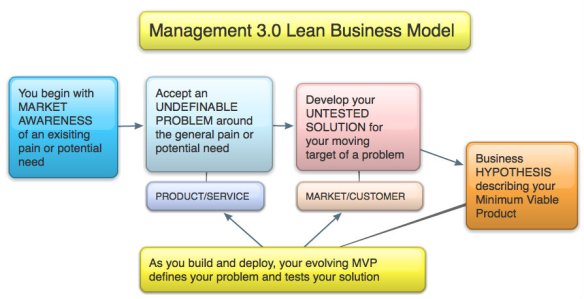 Management 3.0 – a psychological shift
Management 3.0 – a psychological shift
You have a great business idea but you are not sure how to develop it. Should you follow conventional wisdom and write-up a thirty-page business plan? No. In my management 3.0 model, startups will have more success if they adopt lean and agile business development principles, where failing fast is the premium strategy and the lean business model reigns supreme.
I first encountered the idea of developing a one-page business model in 2007 when I came across the Osterwalder model on the web. This struck me as an attractive alternative to the starting point for a business instead of, say, a 30-page business plan. What I didn’t understand then, was that the beauty and power of a business model is not that it is just a boiled down summary of a business plan, but rather a way to change my psychological approach to building a business. Nobody was around to tell me this, so my startup (an early attempt to gamify corporate wellness), died a needlessly slow and painful death.
Fortunately, it all clicked when I encountered the literature around lean startups. In this article, my description of management 3.0 for business models draws on the work of several very bright entrepreneurs and thinkers, including: Alex Osterwalder, Steve Blank, Eric Ries, and Ash Maurya. I include links to their work at the end of this piece. I have also taken ideas from the efforts of Tor Grønsund and Rob Fitzpatrick.
It begins with a different starting point
Now that you have an idea for your business, or perhaps your company has an idea for a new division, or you want to reboot, either way you need a business model. “But wait!” you might say. “What about doing market research?” Good point. In the management 3.0 process, some market research can still be done during the idea development stage. But things have changed. It is now possible to shift a large part of the market research into the product development phase. You do this by launching sooner than later. And you start by developing the simplest working version of your idea. You call this your minimum viable product (MVP). MVPs, continuous deployment, rapid iterations all represent major changes in growing a business. All of which is possible because of something I call, the collapse of the customer feedback float.
The collapse of the customer feedback float
In 1982 John Naisbitt wrote, in his classic book on future studies Megatrends, about the collapse of the information float. He defined the information float as the amount of time information spends in any media channel. The float was the amount of time between transmission and reception. As technology-satellites, cellular networks, etc…- made the transmission and reception nearly instantaneously, this float collapsed.
Today, technologies such as social media, smart phones, high-speed data mining, ubiquitously networked electronic devices, etc… have precipitated the collapse of the customer feedback float. This float refers to the amount of time it takes a vendor to understand whether their product suits the market’s interests. As this float collapses, what used to take longer to figure out, costing a great deal, can now be determined faster and much cheaper. This collapse of the customer feedback float becomes part of the new psychology behind the lean business model.
The old school approach to business modeling
To contrast the differences I’ve been explaining, let’s breakdown the old school approach to business modeling (Figure 1 – below). First, you would do market research to gain some insight into a potential market or an underserved market. This would result in a prospective idea/solution. This idea would then be expanded into products/services to address the possible market need.
In this way, the old system would produce a defined solution for a defined problem. From this, a detailed plan for execution filled with scope and projections would rise up out of the business ether like Mount Olympus. Hopefully, all the expensive market research was right on and success would follow. Unfortunately, most of the time, it wasn’t. What did follow, almost every time, was creeping or even ballooning scope, increasingly large investments to support a lengthy development process with little iterative feedback, and a big resource commitment to create an amazing product or service that the in the end market may not actually want.
Now let’s consider what the collapse of the customer feedback float makes possible.
When you launch a minimally viable version of your product or service, the current uber-connected market place allows you to get high quality feedback from your potential markets almost immediately. This data can then inform your development process, ensuring that you are building products based on real-time, market demand. Developmental efficiency increases because it comes from shorter, iterative, development cycles that hew more closely to products and services the market actually wants. However, the really interesting benefit to this act-analyze-adjust approach is the way it impacts organizational and personal psychology.
The new lean business model – embracing the undefinable
By moving from a long view of development to an iterative view, you must be ok with not knowing all the answers. This is a psychologically superior position because it allows for greater innovation, resilience and adaptability. The old school methods of long-term planning and development created a false sense of security or pseudo-stability that has long been valued by stifling corporate bureaucracy. Overcoming this tendency gives both the new startup and the rebooting business a big advantage.
So, the basis for the old business model was that market research leads to a defined problem that leads to a defined solution that leads to big scope development which then risk a great deal of resource. So what does a Management 3.0 business model look like?
As a Management 3.0 lean business model entrepreneur you:
1) Take a step back from any pre-defined ideas about a product or service and think about possible consumer pains or undiscovered needs and…
2) Assume that you have an undefinable problem around a general pain or potential consumer need.
3) You then put forward an untested solution for your moving target of a problem.
4) Next you describe your Minimum Viable Product. This is your business hypothesis.
This approach (see figure -2) represents a new psychological positioning for the entrepreneur. The challenge is to admit that you only have an untested solution for an unproven problem. So what is the benefit to taking this position of uncertainty? You can now develop a business model around an evolving hypothesis that is subject to constant testing and iteration. This working hypothesis becomes your minimum viable product.
The Management 3.0 lean business model canvass (Figure -3)
At this point, you are ready to write a business model around this hypothesis that begins with answering eight questions, and after filling out your lean canvas you begin testing your M.V.P. hypothesis in a cyclical approach.
The cycle is simple:
- ACT – design, build, code, develop;
- ANALYSE – release, test, measure, discuss;
- ADJUST – design, build, code, develop;
Rinse, lather, repeat…
Each newly tested version of your evolving hypothesis – a.k.a. your iterating Minimum Viable Product gets plugged back into your business model. The eight questions can then be revisited and your model continues to adapt to market reality.
The Eight Questions
Four questions expand on the product side (your untested solution) and four describe your approach to the market (your undefined problem). Remember, the undefined status is an asset because it keeps you in a testing, innovating mindset.
Product questions: built around your initial business hypothesis or M.V.P.
1) Outside support – what other businesses and services will you draw on for support?
- Potential partners
- Cloud SaaS providers
- Incubators, accelerators, business networks
- Investors
- Marketing partners
2) Development – what tech or other resources will you need to build your business?
- Open source, SaaS, existing platforms
- Programmers, UX/AI, MBA, agile product/project manager, other specialists…
- User generated content, crowd sourcing
3) Key Metrics – how will you get and measure continuous customer feedback?
- A/B testing
- Continuous deployment assessments
- SEO, SMO and other new media stats
- Landing page conversions
- New customers acquired
- Demographic analysis of individuals (potential customers) applying to become customers, and the levels of approval, rejections, and pending numbers.
- Status of existing customers
- Repeat behavior
- Customer attrition
- Turnover (i.e. revenue) generated by segments of the customer population.
- Customer lifetime cycle and lifetime value
4) Costs – what is your cost per sale/customer?
- Pro-rated fixed costs
- Variable costs
- What are your economies of scale (how much less will produce more of your product cost)
- What are your economies of scope (what other products or services can you use offer using your existing structure)?
Market questions: built around your untested solution and who you feel will be interested
5) Target Audience – who will want this product?
- Define and describe the demographic(s)
- Psych profile
- Niche vs. mass
6) Unique Advantage – what makes customers choose you over your competitor?
- What makes you unique?
- What do you do that will be difficult for your competition to copy or buy?
7) Customer development – how will you connect to and interact with your customers?
- Web marketing: SEO, SEM, SMM,
- Internet advertising
- PR – blogs, press releases,
- Events, demos, conventions
- TV, radio, magazines, newspaper
- Direct mail, flyers
- Polls, surveys,
- Beta testing
- CRM options (sales force, pipeliner, google apps…)
8) Revenue – how will you make money?
- Single sales
- Repeatable sales
- Subscription service
- Freemium to premium model
- Add-ons
- Advertising revenues
- Licensing/commissions
- Sales projections (what are they based on?)
- Projected customer life cycle and lifetime value
My canvas is one of several iterations based on the original Osterwalder version. All of them have value. Although this one is especially suited for agile development. The important thing is to start with one and begin testing your hypothesis.
A Better Way to Think
Allowing your perspective to shift from a big-plan-specific vision to a fluid-discovery-process is an important part of Management 3.0. Seeing business growth as a series of discrete discoveries instead of an overreaching plan wires your brain for flexibility. This, in turn, will enhance your creativity and your ability to innovate. As you can see, Management 3.0 is more than just new tools for growing your business. It is a new way of thinking; a clearer, braver way to think.
———————–
Here are some links for more insight into this topic:
Osterwalder’s Business Model
Ash Maurya
Eric Ries
Steve Blank
Tor Grønsund
Rob Fitzpatrick
Looking forward to your comments and please share if you like 🙂




Pingback: Vision Logs – the new way to do mission statememts | Ask Atma